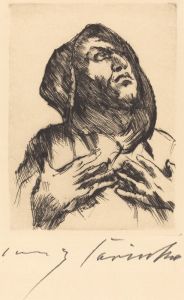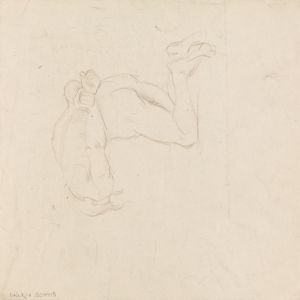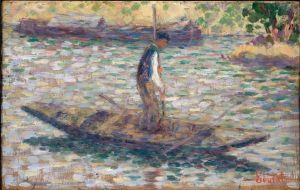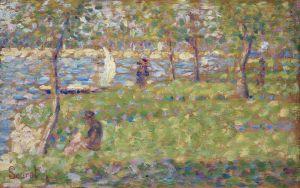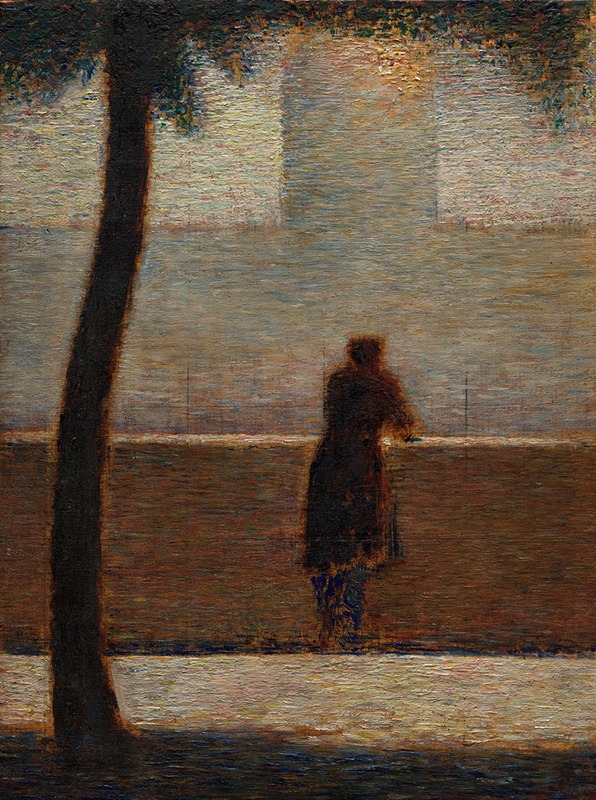
A Man Leaning on a Parapet
A hand-painted replica of Georges Seurat’s masterpiece A Man Leaning on a Parapet, meticulously crafted by professional artists to capture the true essence of the original. Each piece is created with museum-quality canvas and rare mineral pigments, carefully painted by experienced artists with delicate brushstrokes and rich, layered colors to perfectly recreate the texture of the original artwork. Unlike machine-printed reproductions, this hand-painted version brings the painting to life, infused with the artist’s emotions and skill in every stroke. Whether for personal collection or home decoration, it instantly elevates the artistic atmosphere of any space.
Georges Seurat, a pivotal figure in the post-impressionist movement, is renowned for his innovative technique known as pointillism, which he used to create vibrant and luminous paintings. One of his lesser-known works, "A Man Leaning on a Parapet," exemplifies his meticulous approach to capturing light and form through this technique.
Seurat was born in Paris in 1859 and studied at the École des Beaux-Arts. He was deeply influenced by scientific theories about color and perception, which he applied to his art. His most famous work, "A Sunday Afternoon on the Island of La Grande Jatte," showcases his pointillist technique, where small dots of color are applied in patterns to form an image. This method is also evident in "A Man Leaning on a Parapet."
"A Man Leaning on a Parapet" is a study in Seurat's exploration of human figures and their interaction with the environment. The painting depicts a solitary male figure leaning casually on a parapet, a common architectural feature that serves as a low protective wall along the edge of a roof, bridge, or balcony. The setting is urban, suggesting a moment of pause amidst the hustle and bustle of city life. The man's posture is relaxed, and his gaze is directed away from the viewer, adding an element of introspection to the scene.
Seurat's use of color in this painting is subtle yet effective. He employs a limited palette, focusing on muted tones that convey a sense of calm and contemplation. The background is rendered in soft hues, allowing the figure to stand out while still integrating harmoniously with the surroundings. The play of light and shadow is carefully constructed, demonstrating Seurat's keen understanding of how light interacts with surfaces.
The composition of "A Man Leaning on a Parapet" reflects Seurat's interest in geometry and structure. The parapet itself acts as a horizontal line that anchors the composition, while the vertical lines of the man's body and the surrounding architecture create a sense of balance and stability. This structural approach is characteristic of Seurat's work, where he often used geometric principles to organize his compositions.
While "A Man Leaning on a Parapet" may not be as widely recognized as some of Seurat's other works, it offers insight into his artistic process and the themes that interested him. The painting captures a fleeting moment of solitude and reflection, inviting viewers to consider the relationship between individuals and their environments.
Seurat's contributions to the art world extend beyond his paintings. His development of pointillism influenced numerous artists and movements, including the Neo-Impressionists and the broader post-impressionist movement. His work laid the groundwork for future explorations of color and form, impacting artists such as Paul Signac and Henri Matisse.
In summary, "A Man Leaning on a Parapet" is a testament to Georges Seurat's innovative approach to painting and his ability to convey complex ideas through simple compositions. The painting exemplifies his mastery of pointillism and his interest in the interplay between light, color, and form. Through this work, Seurat invites viewers to pause and reflect, much like the solitary figure depicted in the scene.









